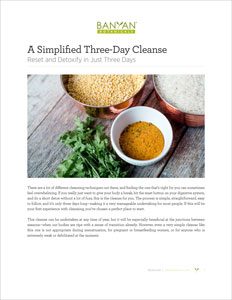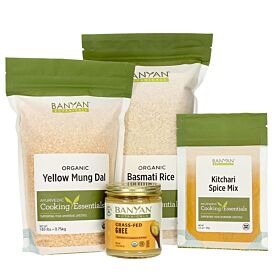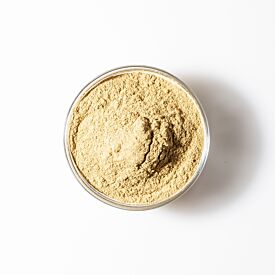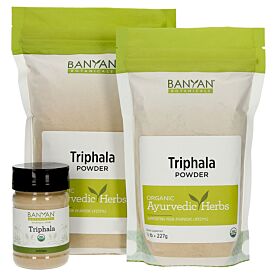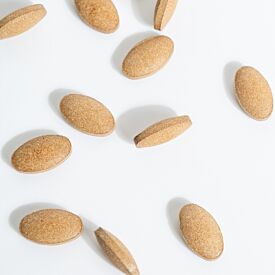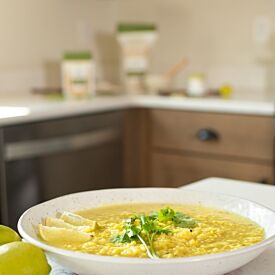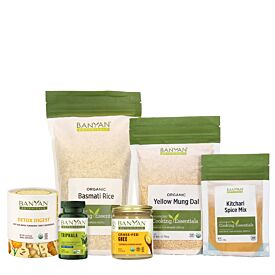A Simplified Three-Day Cleanse
There are a lot of different cleansing techniques out there, and finding the one that’s right for you can sometimes feel overwhelming. If you really just want to give your body a break, hit the reset button on your digestive system, and do a short detox without a lot of fuss, this is the cleanse for you.
The process is simple, straightforward, easy to follow, and it’s only three days long—making it a very manageable undertaking for most people. If this will be your first experience with cleansing, you’ve chosen a perfect place to start.
This cleanse can be undertaken at any time of year, but it will be especially beneficial at the junctions between seasons—when our bodies are ripe with a sense of transition already.
However, even a very simple cleanse like this one is not appropriate during menstruation, for pregnant or breastfeeding women, or for anyone who is extremely weak or debilitated at the moment.
What to Expect
This three-day cleanse is generally safe for a diverse range of constitutions and imbalances (if you don't know yours, take our Ayurvedic Profile™ quiz). Still, any cleanse can be exhausting, emotionally taxing, and physically uncomfortable due to the nature of the detoxification process. This cleanse is extremely gentle and should not cause a great deal of discomfort, but you may still experience some ups and downs—on either emotional or physical levels.
Benefits
The practice of cleansing is considered a vital part of an Ayurvedic lifestyle. It provides an important means of clearing accumulated waste and toxicity from the mind and the tissues, encouraging optimal health.
These days, a periodic cleansing regimen is more vital to our health than ever before. Our bodies are being asked to process a seemingly endless barrage of harmful inputs such as environmental toxins, processed foods, unresolved emotions, and psychological stress.
This particular cleanse is based on eating a monodiet of whole grains and kitchari, drinking plenty of detoxifying fluids, and taking Triphala in the evening to support digestion, elimination, and the body’s natural detoxification processes.
This regimen supports the physiology by slowing the flood of harmful inputs and by providing the body with an important opportunity to rest, recuperate, and repair itself.
A simple three-day cleanse can help:
- Improve digestion and metabolic function.
- Promote regular and balanced elimination.
- Support the maintenance of a healthy body weight.
- Nurture an improved sense of energy, vitality, and enthusiasm for life.
- Foster clarity and groundedness in the mental, spiritual, and emotional spheres.
- Encourage a balanced sleep cycle.
- Promote improved overall health.
The foods ingested during this cleanse are very easy to digest and therefore help to improve the strength of agni (the metabolic fire)—which is essential to optimal health.
If the concept of agni is new to you, you might appreciate reading The Importance of Healthy Digestion: An Ayurvedic Guide to Understanding Agni, which will provide a useful context for your cleansing process.
Planning for Your Cleanse
The more completely you can clear your schedule for the entirety of your three-day cleanse, the better. More importantly, pick a time when you can minimize your exposure to stress. Ideally, you would not be working at all during the cleanse.
If this is not realistic for you, we recommend scheduling the first day or two of your cleanse over your weekend so that you can get familiar with the diet and the routine before you are juggling the cleanse alongside work obligations.
You’ll also want to avoid any social engagements that would make it difficult to maintain the simple diet prescribed below.
In general, eliminate any unnecessary commitments and give yourself as much unstructured time to rest as possible. A menstruating woman should also schedule her cleanse around her cycle so that she is not bleeding at any point during the three-day cleanse.
Once you have found a workable timeframe, put your cleanse on the calendar and come up with a plan for acquiring the necessary supplies ahead of your start date (see our recipes and shopping lists at the end of this article). When the cleanse starts, you will want to focus your energy on the process of detoxification and renewal.
If you are in the habit of taking coffee, caffeine, tobacco products, alcohol, or any recreational drugs on a regular basis, you may find it helpful to gradually reduce or eliminate their use in the days leading up to your cleanse.
Similarly, reducing your intake of fast foods, processed foods, meat, refined sugars, and sweets ahead of the start date can be very beneficial.
You might also consider enlisting the support of close friends or family members who know what you are up to, what your intentions are, and can help to encourage you through the process.
The Cleanse Itself
During the three-day cleanse, you will be eating a simplified diet of oatmeal and kitchari. This diet is substantive enough that you can maintain your essential responsibilities while resetting the digestive system, supporting the elimination of toxins, and balancing vata, pitta, and kapha.
Freshly prepared foods are best, so you’ll want to cook your oatmeal, kitchari, and teas fresh each day—at whatever time works best with your schedule.
While you’ll want to avoid eating leftovers from previous days, it is acceptable to prepare all of your food for the day in the morning, if that works for you. Garnishes such as cilantro chutney and sesame seed chutney can usually be kept for several days without issue.
It is not uncommon to experience mild reduction in bowel movements during a cleanse. If your bowel movements slow in frequency or volume, or if your stools become more difficult to pass, please see our resource on how to rebalance elimination.
Healthy elimination is critical to the detoxification process, so it is best to be proactive about relieving any discomfort as soon as you are aware of it.
The Diet
Breakfast. For the first meal of the day, you can choose between eating kitchari or simple oatmeal.
Lunch and Dinner. For the other two meals of the day, eat kitchari. You can add a little melted ghee, fresh coriander chutney, and sesame seed chutney to ensure that your system stays well-lubricated and that you continue to enjoy all six tastes in your diet.
Veggies & Sides. If the monodiet is causing a sense of deprivation, you can try steaming your vegetables and serving them as a separate side dish, garnished with a little melted ghee, a squeeze of lemon juice, and a pinch of salt. Or, have a side of 1/2 avocado with lemon juice and a sprinkle of salt.
Morning Routine
Wake Up Early. Rise early enough to give yourself a spacious and relaxed morning.
Scrape Tongue and Brush Teeth. Upon waking, scrape your tongue with a tongue cleaner and brush your teeth with a natural formula like Tooth Powder.
Drink Hot Water. Sip 8–16 ounces of hot water to cleanse the system and to awaken the digestive capacity.
Do Some Gentle Exercise (optional). Slow, gentle movements will support cleansing; more than that can be counterproductive. Consider walking, tai chi, qigong, or gentle yoga such as vata-pacifying yoga (which is appropriate during a cleanse). This is not a time to push yourself physically.
Take a Bath or Shower. Use a natural soap only where needed (ideally not all over the body).
Prepare Food and Teas. After that, you’ll want to have plenty of time to prepare your breakfast, kitchari, and teas for the day without undue stress.
Throughout the Day
Eat at Consistent Times. If possible, have breakfast between 7–8 a.m., lunch between 12–1 p.m., and dinner between 5–6 p.m. Allow at least three hours between meals, and eat enough at each meal to feel satisfied without overeating.
Eat Dinner Early. Try not to eat after 6 p.m. or 7 p.m. at the latest.
Avoid Snacking Between Meals. If you need a little something extra, you can enjoy some fresh fruit or a few raw nuts.
Stay Hydrated. Drink at least 8–12 cups of room temperature, warm, or hot fluids each day to ensure adequate hydration and to help flush toxins from the system. Ideally, most of your fluids should be taken between meals. Appropriate fluids include water, CCF Tea, rehydration tea, and detox teas like Detox Digest. Drink as much of any of these as you like.
Evening Routine
Take Triphala. About a half hour before bed, steep 1/2 teaspoon Triphala powder in a cup of freshly boiled water for ten minutes. Cool and drink. Or, take two Triphala tablets with a glass of warm water.
Retire for the Night by 10 p.m. Sleep is the body’s best time to detox so be sure to get plenty of rest throughout the cleanse.
A Supportive Lifestyle During Your Cleanse
- Keep your activities as quiet and mindful as possible.
- Surround yourself with things that you find uplifting and nourishing.
- Minimize stress and exposure to frantic or disturbing environments.
- If intense emotions arise during or after your cleanse, greet your emotions with compassion, observe them with detached awareness, and allow them simply to move through—honoring yourself in the process.
- Rest as much as possible. You can ensure that the bulk of your energy is devoted to cleansing by minimizing the number of resources that your body allocates elsewhere.
After Your Cleanse
After you complete this simple, three-day cleanse, your body may continue to process toxicity for a few days. And, your digestive system will have become accustomed to a very clean diet; you may even be somewhat sensitive to overly stimulating or processed foods.
A slow transition back into your normal routine and a more diverse diet will help to properly restore your body and preserve the benefits of your cleanse. For a couple of days afterward, eat primarily simple, whole foods, gradually diversifying your menu. This is not the time to celebrate with pizza and a beer!
Also, pay special attention to how you handle potentially aggravating foods like dairy, wheat, soy, and nightshades after your cleanse. Your body may have some new information to offer you about your relationship with specific foods.
A Fresh Start
While this cleansing model is incredibly short and simple, it can be quite powerful. According to Ayurveda, balanced agni is the key to optimal health and longevity. Our bodies are incredibly intelligent, and the three-day cleanse gives them an important opportunity to strengthen agni.
So, while it may seem hard to believe, even a simple cleanse like this one can initiate dramatic improvements in the quality of your digestion and elimination, your cravings, your energy level, and your overall well-being.
As you wrap up the cleanse, take some time to reflect on your life so that you can move forward with whatever new intentions feel important to you. This is a potent time to cultivate a deeper level of inner awareness, to listen to your body, and to honor every aspect of your being as you transition out of the cleanse.
You might also take some time to appreciate your body for all the ways it serves and supports you. Remember too, that you’ve offered yourself a valuable gift with this cleanse—one that requires a certain level of discipline and commitment. Congratulations on your accomplishment. We hope that it serves you in a multitude of gratifying ways.
Recipes
Remember that your food will absorb the energy of your mindset and state of being while you are cooking. You can assist your healing process by bringing good intentions and a sense of presence into your kitchen.
Simple Oatmeal
Kitchari is traditionally eaten three times a day during an Ayurvedic cleanse, but this simple oatmeal recipe is a good alternative if preparing kitchari before breakfast is not realistic for you. This recipe can also provide a helpful break from the kitchari monodiet—which is especially important if you tend to tire of similar foods easily.
While fruit and grains are typically considered a poor food combination, oats are a particularly light grain and are generally quite digestible. The taste profile of oats also has a lot in common with these particular fruits, which makes them more compatible.
In addition, when fruits and oats are cooked together, their more diverse qualities are able to mingle in a way that further improves their digestibility.
Ingredients
- 1/2 cup dry rolled oats
- 1 1/2 cups water
- 1/4 cups raisins
- 1/2–1 cup fresh apple, apricot, peach, or pear (cut into small pieces)
Optional Warming Spices
- 1/4 teaspoon cinnamon powder
- 1/4 teaspoon nutmeg
- 1/8 teaspoon cardamom powder
- 1/8 teaspoon ginger powder
Directions
Combine the raisins, cut fruit, 1 cup water, and any desired spices in a small saucepan and bring to a boil on medium-high heat.
Reduce heat and simmer for ten to fifteen minutes, or until the fruit is tender and well-cooked (apples may take a tad longer).
Add the oats, the remaining 1/2 cup of water, stir, and return to a boil.
When the mixture boils, stir thoroughly, remove from heat, cover, and let stand for five to ten minutes, until the oats are soft and the water is absorbed. Cool and serve.
Oatmeal Dosha Variations
Vata. Favor fruits like apricots and peaches. The optional spices will offer a tasty addition of warmth to this dish.
Pitta. Favor fruits like apples and pears. If there is pitta imbalance, favor cinnamon and cardamom, and consider reducing the quantity. For severe pitta imbalance (or if the season is hot) consider foregoing the spices altogether.
Kapha. Any of the fruit mentioned above is fine. If you are primarily focused on balancing kapha, you may also want to try this delicious kapha-pacifying modification: simply combine a couple of varieties of cut fruit, omit the oats and the second batch of water, follow the rest of the recipe as it is, and enjoy a breakfast of stewed fruit.

Tridoshic Kitchari
Kitchari is a stew-type meal that is prepared from basmati rice and split mung dal. During a cleanse, appropriate vegetables provide texture, flavor, and an important source of fiber.
Kitchari is very easy to digest, which makes it a wonderful food for any cleansing regimen. It allows the digestive system to rest, allocating extra energy to the body’s natural detoxification processes.
The quantities in this recipe provide a good starting point for a day’s supply of kitchari, but as you learn your preferences and habits, you are welcome to adjust the quantities to better fit your needs.
Feel free to make any ingredient adjustments to adapt this recipe to your own unique needs. For example, you may want to use another grain in place of basmati rice or coconut oil instead of ghee.
Ingredients
- 1 cup white basmati rice
- 1/2 cup yellow mung dal
- 2 tablespoons ghee
- 1 tablespoon kitchari spice mix*
- 1 teaspoon natural mineral salt
- 6 cups water
- 2 cups easily digestible vegetables (such as asparagus, carrots, celery, green beans, summer squash, sweet potato, winter squash, or zucchini)
*Spice Mix
If you’d like to create your own spice mix for kitchari, follow this recipe. Or, you can save time with our ready-made Kitchari Spice Mix.
- 1/4 teaspoon black mustard seeds
- 1/2 teaspoon cumin seeds
- 1/2 teaspoon turmeric powder
- 1 1/2 teaspoons coriander powder
- 1/2 teaspoon fennel powder
- 1 pinch hing (asafoetida)
- 1 teaspoon fresh grated ginger
Directions
Soak the split mung dal overnight (or for at least four hours).
Strain the soaking water, combine with the rice and rinse the mixture at least twice, or until the water runs clear, and set aside.
In a medium saucepan or soup pot, warm the ghee over medium heat. Add the black mustard seeds, cumin seeds and sauté for a couple of minutes, until the mustard seeds begin to pop.
Add the turmeric, coriander, fennel, hing, and fresh ginger. Stir briefly, until aromatic.
Stir the rice and dal mixture into the spices and sauté for a few moments, stirring constantly.
Add the 6 cups of water, turn heat to high, and bring to a boil.
When the soup comes to a boil, stir in the salt, reduce heat, cover, and simmer for about forty minutes.
Meanwhile, cut your vegetables into small, bite-sized pieces. About halfway through the kitchari’s cooking process, stir in the vegetables and allow the stew to return to a boil.
Continue to simmer until the rice, dal, and vegetables are fully cooked. Remove from heat, cool, and serve.
Note: some vegetables, such as sweet potatoes and winter squash, might require more cooking time and may be added earlier, if necessary.
Aim to have very little water remaining when finished. The consistency should be that of a vegetable stew as opposed to a broth. While you want the beans, rice, and vegetables to be thoroughly cooked, excess water and over-stirring can cause the ingredients to become thick and gummy.
Garnish the kitchari with your choice of fresh cilantro, coriander chutney, and sesame chutney. Enjoy!
Fresh Coriander Chutney
This tridoshic recipe from The Ayurvedic Cookbook by Amadea Morningstar is very tasty and is especially useful for reducing excess pitta.
Ingredients
- 1 bunch (1/4 pound) fresh coriander leaves and stems (also known as cilantro or Chinese parsley)
- 1/4 cup fresh lemon juice
- 1/4 cup water
- 1/4 cup grated coconut
- 2 tablespoons fresh ginger root, chopped
- 1 teaspoon barley malt or raw honey
- 1 teaspoon natural mineral salt
- 1/4 teaspoon fresh ground black pepper
Directions
Blend the lemon juice, water and fresh coriander until the coriander is chopped. Add the remaining ingredients and blend until it is like a paste.
Use sparingly. This chutney can be stored in a covered container in the refrigerator for up to one week. For a silkier texture, use only the leaves and the tops of the fresh coriander stalks.
Sesame Seed Chutney
This tridoshic recipe from Ayurvedic Cooking for Self-Healing by Usha and Vasant Lad is especially good for people with vata and kapha imbalances. Reduce cayenne pepper to 1/4 teaspoon if there is any pitta imbalance, or eliminate it entirely.
Ingredients
- 1 cup roasted and ground sesame seeds
- 1 teaspoon cayenne pepper
- 1/4 teaspoon natural mineral salt
Directions
Blend ingredients together and garnish kitchari with about 1 teaspoon of the mixture.
Alakananda Ma’s Rehydration Tea
This delicious recipe has been provided courtesy of Alakananda Ma.
Ingredients
- 4 1/2 cups pure water
- 2 heaping teaspoons peppermint or fresh mint
- 1 heaping teaspoon brahmi gotu/kola powder
- 1/4 teaspoon natural mineral salt
- 1/4 lime (squeezed juice)
- 2 teaspoons turbinado sugar
Directions
Boil water. Remove from heat and add herbs, salt, and lime.
Steep ten minutes, strain, add turbinado, and drink warm or at room temperature.
Shopping List
Amounts recommended are approximate and may need to be adjusted according to your needs.
Herbs & Products
While you will certainly have leftovers of any Ayurvedic herbs you order for your cleanse, you can continue to take any of them after the cleanse to support further detoxification.
- Triphala powder (1/2 ounce) or Triphala tablets (6 tablets)
- Tongue Cleaner
- Optional: Brahmi/Gotu Kola powder for rehydration tea (1/2–1 ounce)
- Optional: Vata Digest, Pitta Digest, or Kapha Digest tablets can be taken after meals to improve agni (nine tablets)
Groceries
- Organic White Basmati Rice, (21 ounces)
- Organic Yellow Mung Dal (12 ounces)
- Organic Ghee, clarified butter—available at most health food stores (6 ounces)
Optional:
- Organic rolled oats (1 1/2 cup or 6 ounces)
- Optional: raisins (3/4 cup or 4 1/2 ounces)
- Apple, apricot, peach, or pear (1 1/2–3 cups)
- Organic roasted sesame seeds (1 cup per batch of sesame seed chutney)
Vegetables for kitchari (6 cups total), such as:
- Asparagus
- Carrots
- Celery
- Green beans
- Summer squash
- Sweet potato
- Winter squash
- Zucchini
Spices and garnishes to have on hand
- Black mustard seeds
- Black pepper
- Cilantro (1/4 pound per batch of fresh coriander chutney)
- Cumin seeds, whole
- Coconut, unsweetened and shredded
- Coriander powder
- Fennel powder
- Ginger root, fresh
- Hing (asafoetida)
- Lemons
- Limes
- Mint, fresh, or dried peppermint
- Natural mineral salt
- Sweeteners: Barley malt or raw honey; turbinado sugar
- Turmeric powder
Optional spices and garnishes:
- Cardamom powder (for oatmeal)
- Cayenne pepper (for sesame seed chutney)
- Cinnamon powder (for oatmeal)
- Ginger powder (for oatmeal)
- Nutmeg (for oatmeal)
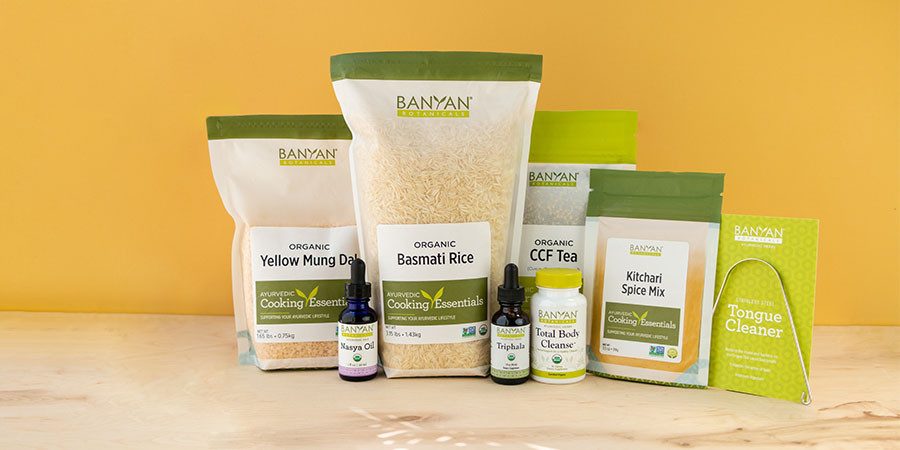
Cleanse Products
Or, save time and money with one of Banyan’s cleanse products:
- Banyan’s Kitchari Kit contains a seven-day supply of Organic Basmati Rice and Yellow Mung Dal, as well as Kitchari Spice Mix and Ghee.
- For an even more convenient and customizable option, Banyan’s Cleanse Bundle allows you to select which items you’d like, and also features CCF Tea.
Additional Resources
For more information on Ayurvedic Cleansing, click here to return to our cleansing department.
To explore the Ayurvedic practice of rasayana (rejuvenation), please see our rejuvenation department.
For more information on agni and why it is so critical to our overall health, you may enjoy our piece on The Importance of Healthy Digestion.
For more on ama (natural toxins), please see our article on Ama: the Antithesis of Agni.
Frequently Asked Questions:
Q: I am interested in losing weight. Will this help?
A: Cleansing is a great way to reset the digestive system so that it can function at its best, which can support healthy weight management. That said, Ayurveda offers many other ideas on this topic as well. If you haven't already, consider checking out our guide on How to Lose Weight with Ayurveda.
Q: I'm an athlete and can't take too many days off of high intensity exercise. Can I still do this cleanse, or modify it in some way?
A: Yes! You can modify your cleanse in any way that best suits your individual needs, so it is certainly possible to continue with your normal exercise routine. Do your best to incorporate space for rest and rejuvenation in other ways, such as getting plenty of sleep, taking time for yourself, or winding down with restorative yoga. You may also want to supplement your meals with additional simple, easy-to-digest foods for extra nutritional support.
Q: I am actively trying to get pregnant. Is it safe to do a cleanse?
A: In most cases, yes! Cleansing is actually recommended as one of the steps to prepare the body for conception. We have more information about this in our Preparing for Pregnancy guide. We also recommend working with your health practitioner to make sure that cleansing is the right choice for you at this time.
Q: I am allergic to legumes, including mung dal. Can I still do this cleanse?
A: We recommend working with an Ayurvedic practitioner to find the right cleanse for your needs. Traditional Ayurvedic cleansing necessitates the use of rice and dal, with the dal providing a large portion of the necessary protein content to sustain the body over the course of the cleanse. That said, it is possible to create a custom digestive reset that meets your dietary needs. A practitioner would be able to recommend the right foods to support you.
Q: Can I use whole mung beans instead of mung dal?
A: Absolutely! Green mung beans are considered balancing for all doshas and can be substituted for yellow mung dal. Just be aware they will need to be soaked and will require a longer cooking time.
Q: I am allergic to oatmeal. What should I eat for breakfast?
A: No problem! Oatmeal is not necessary for this cleanse and is just recommended as an alternative breakfast for those who want a break from kitchari. Some people prefer to eat kitchari for all the meals of their cleanse. Quinoa and amaranth are both suitable substitutes as well.
Q: Can I use brown basmati instead of white basmati?
A: Brown rices, including basmati, are quite heating, heavy, and rough, and they are more challenging to digest. Ayurvedic cleanses are largely about giving the digestive system a rest by eating a simple kitchari mono-diet that is exceedingly easy on the digestive system. For this reason, white basmati is recommended while cleansing.
Q: Can I eat nut butters during my cleanse?
A: In general, nuts and nut butters are not included in an Ayurvedic cleanse. A small amount can be okay for vata and pitta if you feel the need for extra nutrition, but if you are focusing on kapha balancing during this cleanse, we recommend avoiding nuts and nut butters.


